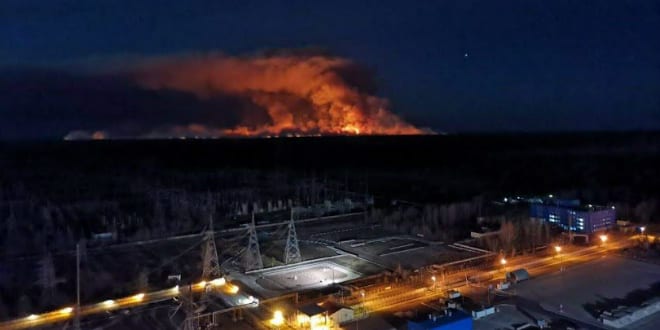Over 1,000 firefighters are struggling to control wildfires at the Chernobyl nuclear disaster site despite high-winds that threaten to send radioactive smoke to nearby residents as well as neighboring countries.
The fire has been burning since April 3. It was successfully extinguished but fires cropped up again on Tuesday. Aerial firefighting equipment including helicopters and airplanes were brought in to fight the blaze earlier this week but high-winds are preventing these elements from being utilized in new blazes that have flared up. The fires are reportedly blazing less than one mile from the remains of the nuclear power plant.
The mass fire in the #Chernobyl Zone has died down thanks to firefighters — and also a heavy rainfall overnight into April 14.
Looks like we finally can breathe a sigh of relief. pic.twitter.com/zGZgKODgIH— Illia Ponomarenko (@IAPonomarenko) April 14, 2020
Police say they arrested a 27-year-old man who is being accused of starting the fire last week. On Monday, police said that another local resident burned waste and accidentally set dry grass ablaze.
In #Kiev, #Ukraine, a dust storm and smog from burned forests near #Chernobyl.
☣ People are asked not to go outside and close all the windows. pic.twitter.com/xb8RWyU7by
— ISCResearch (@ISCResearch) April 17, 2020
Chernobyl was home to a Soviet nuclear power plant which exploded on 26 April 1986 during an emergency drill that was botched, leading to an explosion and the meltdown of its number four reactor. It is still considered the worst peace-time nuclear disaster in history. Though it is uncertain how many deaths can be attributed to the disaster, the estimates range from 4,000-9,000 in former Soviet states to 16,000 fatalities when assessing the total continent of Europe.
The Ukrainian government downplayed any risk of nuclear contamination due to the fires.
“The radioactive background in Kiev and the Kiev region is within normal limits,” Volodymyr Demchuk, director of the Emergency Response Department, said in a video statement.
A one thousand square mile exclusion zone was established around the reactor after the accident. The zone is largely unpopulated, although about 200 people have remained despite orders to leave. There is considerable residual radiation in the surrounding area and experts fear that a fire in the heavily forested area could spread the nuclear contamination.
Source: Israel in the News

